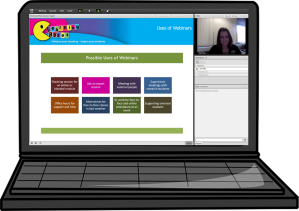One of the discussion threads this week on otTEL is about running online synchronous sessions using platforms like Blackboard Collaborate or Adobe Connect. I have used both these tools for delivering and attending webinars, but I am always looking to improve my skills in this area. I attended a free webinar run by Citrix in March this year on how to create virtual learning sessions, which I found really useful, so thought I would share the notes I made from the session here:
1. How to keep participants engaged and active:
- Call a session by its rightful name; terming a session meeting, presentation, webinar, learning event all create different expectations in terms of participation etc – so make sure you label your session correctly.
- Every 3-5 minutes have the audience do something different to keep attention and prevent multitasking. You have plenty of tools at your disposal including: asking questions; using the whiteboard; using chat; polling; giving a break; thinking time; asking for people to speak; read something; show a video; etc.
- For a small group, a tip to make sure everyone is engaging is to write everyone’s name down on a piece of paper and mark down when they contribute, that way you can invite those who are quieter for their opinion.
2. 3-step instructional design technique:
- Identify goal performance and objectives: the instructional goal is the session’s mission statement; the performance objectives are what the learners will be able to do when they leave the session.
- Determine the assessment needs: how do we know each of the objectives have been achieved? Take each objective separately for this to determine if it suitable for online instruction. A general rule of thumb is ‘if it can be tested online, it can be taught online’.
- Determine collaboration needs: think about if you need to bring people together to learning this thing. What does collaboration bring? Will it make the experience richer? A general rule is that if it does not need collaboration, then it can be taught via self-paced online materials rather than in a collaborative session e.g. learning road signs.
3. Determine when and how to design interaction and collaboration online
- Differentiate between interaction and collaboration. Interaction involves participation including polling and adding ideas to the chat space; collaboration involves working as a group to come up with a solution to a shared problem.
- Two main reasons to include interaction and collaboration: firstly to support participant engagement and secondly to support learning outcomes.
- Interactions are usually at the lower end of Bloom’s taxonomy and promotes communication between the tutor and participants and between the participants.
- Collaborations usually target the higher levels of Bloom’s taxonomy like evaluation, analysis and synthesis and achieves deeper learning.
- The goal with collaboration is to help participants to achieve better results than they would individually.
- Interactions can be serial or concurrent. Serial means that people take it in turns, concurrent means that everyone can participate at the same time. A unique feature of online platforms means that concurrent interactions can take place. If serial interactions take place online, people will quickly start to lose interest and multi-task.
Summary:
- Set realistic expectations for your students.
- Create opportunities for learners to engage.
- Follow the 3-step process to make sure the content is suitable for an online webinar session.
- Ensure that the learners are interacting and collaborating with you, the other participants and the technology.
